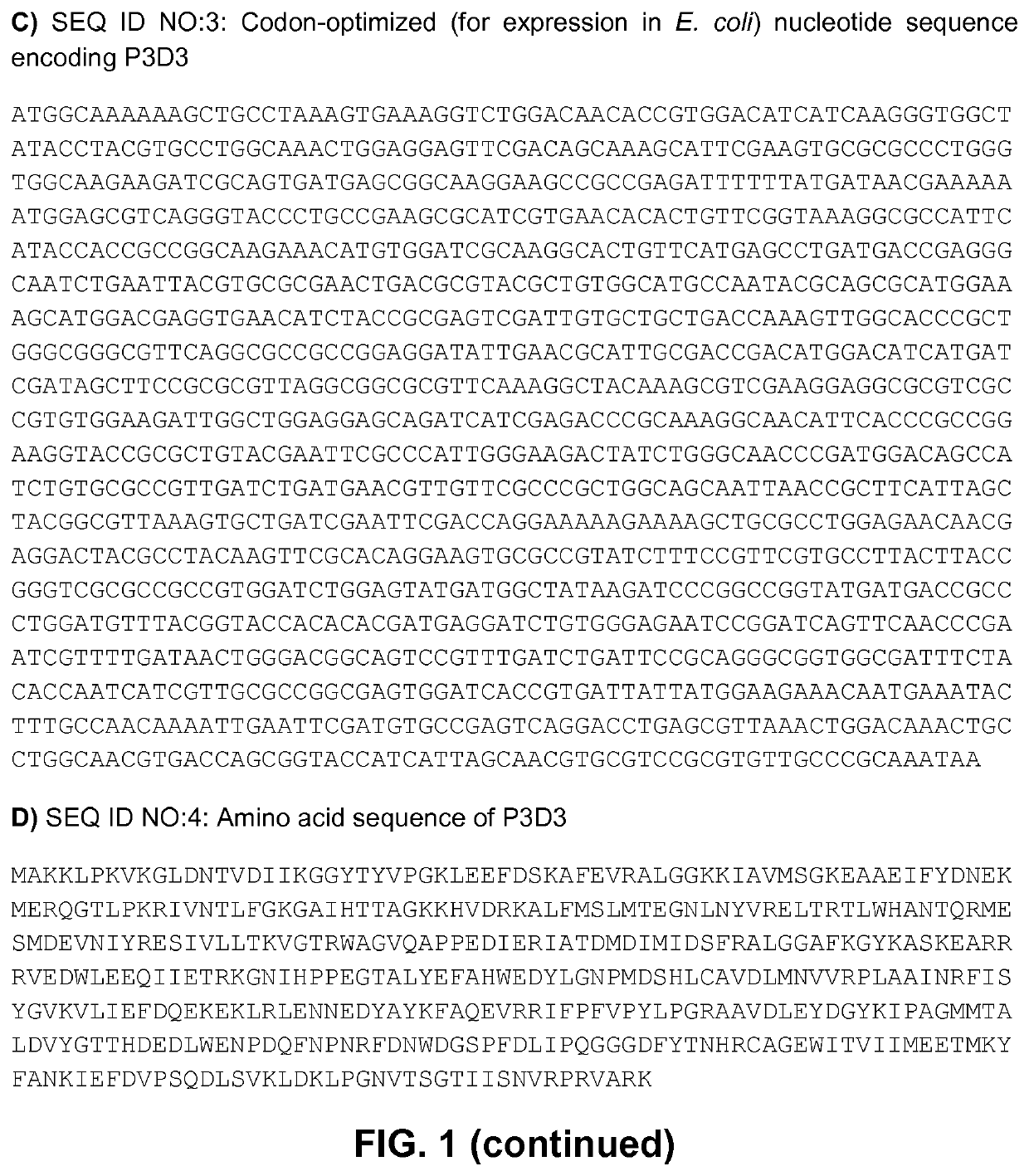Improved cytochrome p450 fatty acid decarboxylases
a cytochrome p450 and fatty acid conversion technology, applied in the field of biocatalysts, can solve the problems of generating unwanted hydroxyl-fatty acid products, unable to achieve an improvement in fatty acid conversion rate, negligible improvement, etc., and achieves high c9 to c15 -olefin production, high decarboxylation activity, and high conversion rate.
- Summary
- Abstract
- Description
- Claims
- Application Information
AI Technical Summary
Benefits of technology
Problems solved by technology
Method used
Image
Examples
example 2
Preference of P13G11
Material and Methods
[0171]The recombinantly expressed and purified P13G11 from Example 1 was incubated with different fatty acid substrates as described in Example 1 to assess the substrate preference of the P13G11 enzyme. Briefly, 200 μl reaction mixtures containing 200 μM of each fatty acid substrate, 220 μM H2O2 and 2 μM of the purified P13G11 enzyme were incubated at 30° C. for 2 hours. Reactions were quenched by the addition of 20 μl of 10 M HCl. The reaction mixture was extracted by 200 μl ethyl acetate. Following extraction, the organic phase was collected and analyzed by gas chromatography as described in Example 1.
Results
[0172]FIG. 3 shows that the C12 fatty acid is the best olefin-producing substrate for P13G11.
example 3
d Decarboxylation and Hydroxylation Activities of Sm46Δ29 and P13G11 at Different Enzyme Concentrations
[0173]Recombinantly expressed and purified Sm46Δ29 and P13G11 from Example 1 were reacted with C12 fatty acid substrate, and the decarboxylation versus hydroxylation activity of the enzyme P13G11 was compared with its wild type parent Sm46Δ29 at different enzyme concentrations and for different incubation times (FIG. 4). In addition, the C12 fatty acid substrate conversion and olefin production ratios were plotted against time to compare the reaction rates of the enzymes (FIG. 5).
Materials and Methods
In Vitro Enzymatic Assays
[0174]2 ml NaPO4 buffer (pH 7.4) containing 200 μM C12 fatty acid substrate, 220 μM H2O2 and 0.5 μM or 2 μM of the purified enzymes were incubated at 30° C. At t=0, 0.5, 1, 2, 5, 10, 15, and 30 min, 200 μl samples were taken from the reaction mixture for studying the reaction rates of the enzymes. At t=40 min and 2 h, 200 μl samples were taken from the reaction...
example 4
d Decarboxylation Activity of P3D3
Materials and Methods
[0179]The coding sequence of P3D3 (SEQ ID NO:3) was cloned into the pET28b plasmid, and recombinantly expressed in E. coli BL21(DE3) cells as described in Example 1. Purification of the P3D3 enzyme was carried out as described in Example 1. 2 ml NaPO4 buffer (pH 7.4) containing 200 μM C12 fatty acid substrate, 220 μM H2O2 and 0.5 μM of the purified P3D enzyme or of P13G11 of Example 1 were incubated at 30° C. At t=0, 0.5, 1, 2, 5, 10, 15 and 30 min, 200 μl samples were taken from the reaction mixture for analysis. The samples were extracted by 200 μl ethyl acetate. Following extraction, the organic phase was collected and analyzed by gas chromatography as described in Example 1.
Results
[0180]P3D3 also showed improved decarboxylation activity against the mid-chain length fatty acids, in particular C12 fatty acid. The time course analysis of the fatty acid decarboxylation activity of this decarboxylase verified its further improved...
PUM
| Property | Measurement | Unit |
|---|---|---|
| total volume | aaaaa | aaaaa |
| pH | aaaaa | aaaaa |
| time | aaaaa | aaaaa |
Abstract
Description
Claims
Application Information
 Login to View More
Login to View More - R&D
- Intellectual Property
- Life Sciences
- Materials
- Tech Scout
- Unparalleled Data Quality
- Higher Quality Content
- 60% Fewer Hallucinations
Browse by: Latest US Patents, China's latest patents, Technical Efficacy Thesaurus, Application Domain, Technology Topic, Popular Technical Reports.
© 2025 PatSnap. All rights reserved.Legal|Privacy policy|Modern Slavery Act Transparency Statement|Sitemap|About US| Contact US: help@patsnap.com



